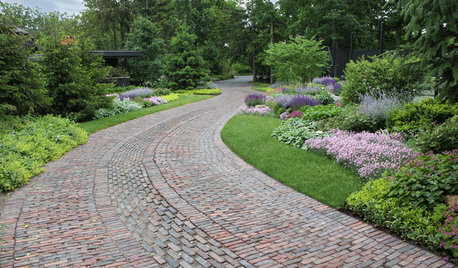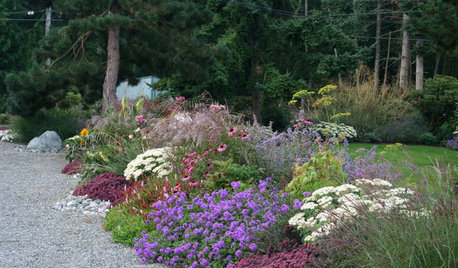White dogwood to line part of our driveway. Yay or nay?
tiffew
7 years ago
Featured Answer
Sort by:Oldest
Comments (53)
Logan L Johnson
7 years agotiffew
7 years agoRelated Discussions
Worth 30$, yay or nay?
Comments (28)Har Har!!! Thank you!! Yesss girl 8D I just couldn't wait to get it apart. The container had no hole and the dyed moss offended me, lol. I resisted the urge to toss it over my shoulder, right, then left as I pulled the wee plants from the container. In fact, please picture me doing so, because in my head, that's what it looked like. I think that counts! The funny thing is, the girl at the counter asked if it was real =0 The lady on line behind DH commented on how it can't be real....I stayed well away because I. can't. even. DH loves it when I stick him in plant stores with chatty plant women =D When I first spotted it, I asked DH to go ask the man if I could just have the cutting & he could replace it with another, or if I had to buy the whole arrangement. Should've seen the look on DH's face, but, bless his heart, he did it =) Of course the answer was, sorry, the boss himself put that together, you have to buy the whole thing. I'm getting to the age where I don't mind embarrassing DH, lol! Look on his face is just priceless, that's what he gets for not holding my bag, everrrrr =D...See MoreOff centered art, yay or nay?
Comments (62)Insightful ANE....bah ha, who wants to spell out aprilneverends. Referencing your thoughts on movies and books and undone. I think I will add the Undone philosophy to "moms take on life" for my boys. Thy can finish this sentence they have heard it so much. Its from the mivie Wonder boys. Don't worry about what other people think. Most people, don't think. "Obviously can't be used in all life situations". We have totally hijacked this thread....See MoreQuarter sawn oak-painted uppers yay or nay
Comments (145)North Iowa here.. What no one on this thread understands is there are no "green spaces" here. We have Habitat ReStore. We have Menard's or maybe Lowe's or Home Depot. Iowa people help each other all the time. Craig's list has junk. I did a kitchen gut 10+ years ago with Menard's hickory cabinets and laminate counters. No back splash. Existing Vinyl floor. Used my just fine white appliances. My house was built in 1880 so no open concept here. My kitchen is a room. A small room by comparison to almost all kitchens on here. I had a handyman who worked cheap. I had known him for at least 30 years so when I left for work I knew he'd deal with whatever came along. He was gone when I got home and I did clean up. I also did the gutting of the old kitchen; dead mice in the light fixture but he warned me about the potential so I was prepared. Maybe I was very, very lucky but I got a great kitchen for $10,000. I don't know what inflation would do to that price today. Compared to what I started with I now have a palace. You are a long way from final plans and I think you will do just fine. It takes a lot of price comparison shopping to get there. And shopping on eBay and Menard's sales. Don't over look the consignment shops. If you do Menard's cabinets wait until they have the 11% off. If you visit the cabinet people there regularly and tweak your layout, you will find people you really like and who like you and they will tell you when the sales are coming up. You can also make your own laminate counters for cheap. I didn't do that 4 inch backsplash thing and even though I didn't do any other kind of backsplash, I'm glad I didn't add it. Right now I have wallpaper but I'm thinking I might tile some paneling that's cut to fit so that if I get tired of it I can pull it off and put something else there....See MoreKitchen Bridge Faucets: Yay or Nay?
Comments (54)" Do you think people using this forum are more thoughtful about function versus form" Yes, I think most people here, at least the "regulars" are function-first people. This does not mean that form/look is not important -- it just means that they consider function more important. In all honesty, it's easy to make or find something functional that looks nice; it's almost impossible to make something that's dysfunctional but looks nice functional without replacing the dysfunctional item (or design). My opinion...I hate side sprayers. I grew up with them, so I speak from a lot experience! But, as you can see from above, others like them -- so it's personal preference. I agree that bridge faucets look nice, especially in period Kitchens, but they are not for me b/c of the sprayer issue. I also like the fact that I can set a one-handle faucet to a temperature I like and then just turn it off with the temp setting till set...and I know that when I turn it back on, it will be at that same setting. This also shows you that functionality preferences can vary by person as well as looks/form. I really like the look and general function of my Kohler Vinnata, but over time I have realized that I do not like Kohler's spray/stream "button". Switching back & forth is not easy b/c you have to hit just the right spot -- and that "spot" for both options is quite small! It looks like the Kohler Artifact may have a different system for changing b/w spray & stream -- maybe Kohler realized their old design wasn't working as well as they hoped. Questions for those with the Artifact.... (1) Does it "remember" what type of spray/stream setting you used last? I.e., if you turn it off while it's on the "Berry Spray", will it still be on the "Berry Spray" when you turn it back on? That's a key feature for me! (2) Do the buttons work well? Do they last long? (I've already replaced the head of my Vinnata once b/c the "button" wore out -- it was free b/c of Kohler's lifetime guarantee, but I'd rather not have to do it!)...See MoreLogan L Johnson
7 years agoToronado3800 Zone 6 St Louis
7 years agoakamainegrower
7 years agokentrees12
7 years agolast modified: 7 years agoken_adrian Adrian MI cold Z5
7 years agorhizo_1 (North AL) zone 7
7 years agoSara Malone Zone 9b
7 years agotiffew
7 years agoSara Malone Zone 9b
7 years agotiffew
7 years agokentrees12
7 years agoSara Malone Zone 9b
7 years agotiffew
7 years agotiffew
7 years agoSara Malone Zone 9b
7 years agoEmbothrium
7 years agolast modified: 7 years agoLogan L Johnson
7 years agotiffew
7 years agoakamainegrower
7 years agotiffew
7 years agoLogan L Johnson
7 years agokentrees12
7 years agotiffew
7 years agoLogan L Johnson
7 years agotiffew
7 years agoLogan L Johnson
7 years agotiffew
7 years agoSara Malone Zone 9b
7 years agoLogan L Johnson
7 years agoakamainegrower
7 years agorhizo_1 (North AL) zone 7
7 years agolast modified: 7 years agoLogan L Johnson
7 years agokentrees12
7 years agotiffew
7 years agoakamainegrower
7 years agoSara Malone Zone 9b
7 years agotiffew
7 years agokentrees12
7 years agotiffew
7 years agoakamainegrower
7 years agokentrees12
7 years agokentrees12
7 years agoakamainegrower
7 years agotiffew
7 years agotiffew
7 years agoakamainegrower
7 years agoLogan L Johnson
7 years ago
Related Stories

COLORBest Ways to Use Radiant Orchid, Pantone's Color of 2014
Learn how to work in this bold fuchsia-pink-purple successfully around the home, and give it a yay or nay in the Houzz poll
Full Story
LANDSCAPE DESIGN6 Driveway Looks Take Landscapes Along for the Ride
See how to design a front yard that makes your driveway its own destination
Full Story
HOLIDAYSGuys, Where Do You Feel Most at Home?
For Father’s Day, we’d like to hear from the men. What part of your house makes you feel most like yourself — grounded and alive?
Full Story
KITCHEN DESIGNThe Cure for Houzz Envy: Kitchen Touches Anyone Can Do
Take your kitchen up a notch even if it will never reach top-of-the-line, with these cheap and easy decorating ideas
Full Story
ARBOR DAY8 Reasons to Plant a Great Tree
Beauty is its own reward, but the benefits of planting the right tree in the right place go way beyond looks
Full Story
FALL GARDENING7 Reasons Not to Clean Up Your Fall Garden
Before you pluck and rake, consider wildlife, the health of your plants and your own right to relax
Full Story
LIFEHouzz Call: How Are You Handling the Record-Breaking Cold?
Share your tales, strategies and photos for everything polar vortex
Full Story
GARDENING FOR BIRDSWild Birds Transform a Woman’s Garden and Life
How Sharon Sorenson created a wildlife haven and became the Bird Lady of Southern Indiana
Full Story
MOST POPULARHow to Design a Colorful Flower Bed
Fall planting: Delight the eye through 3 seasons with bright flowers placed just right. Late summer is the time to plan
Full Story
MY HOUZZMy Houzz: Global-Inspired Color Transforms a Lavish Beach Home
See how a Southern California designer breathes enchantment, color and texture into her family’s coastal home
Full Story




tiffewOriginal Author